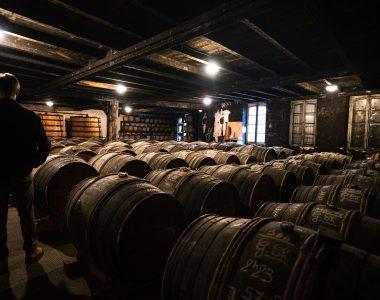
Wine tasting is often described as an art, but it’s also deeply rooted in science. The complex interplay of our senses—sight, smell, taste, and even touch—creates the rich experience that wine lovers cherish. Understanding the science behind wine tasting can enhance your appreciation of wine, helping you to discern its subtle nuances and better articulate what you enjoy. Let’s dive into the sensory experience of wine tasting and explore how our senses work together to create the magic in a glass.
The Role of Sight in Wine Tasting
The first step in wine tasting begins with the eyes. Observing the color and clarity of the wine provides important clues about its age, grape variety, and potential flavor profile.
- Color: The color of wine can tell you a lot about its age and type. White wines range from pale yellow to deep gold, darkening as they age. Red wines, on the other hand, shift from bright ruby or purple to more brick or brown hues as they mature. For example, a young Pinot Noir might have a light, translucent ruby color, while an older Cabernet Sauvignon may show deep garnet with hints of brown.
- Clarity: Clarity, or how clear the wine appears, can indicate the wine’s quality and whether it has been filtered. A clear, bright wine often suggests good quality, while cloudiness might indicate a wine that is unfiltered or one that has started to spoil.
- Viscosity: Swirling the wine in the glass and observing how it moves can give insights into its body and alcohol content. Thicker, slower-moving “legs” or “tears” suggest higher alcohol content or sugar levels.
The Science of Smell: Aromas and Bouquet
Our sense of smell plays a crucial role in wine tasting, as it’s closely linked to our ability to perceive flavor. When we smell wine, we’re detecting volatile compounds that evaporate from the liquid, each carrying distinct aromatic notes.
- Primary Aromas: These are the smells directly related to the grape variety and include fruity, floral, and herbal notes. For instance, Sauvignon Blanc is known for its green, grassy aroma, while Syrah often has hints of black pepper and dark berries.
- Secondary Aromas: These arise from the winemaking process, particularly fermentation. They include aromas like butter (from malolactic fermentation) or yeast (from the lees).
- Tertiary Aromas: Also known as the wine’s bouquet, these develop during the aging process, either in the bottle or in oak barrels. They can include complex scents like vanilla, tobacco, leather, or earth. For example, an aged Bordeaux might exhibit aromas of cedar, tobacco, and dried fruits.
Taste: The Complex Interplay of Flavors
Taste is where the magic happens, as it combines with smell to create the full flavor experience of wine. Our taste buds detect five primary tastes: sweetness, sourness (acidity), bitterness, saltiness, and umami. In wine, sweetness, acidity, and bitterness are the most prominent.
- Sweetness: Residual sugar left in the wine after fermentation contributes to its sweetness. Sweetness can range from the bone-dry crispness of a Brut Champagne to the luscious sweetness of a Sauternes.
- Acidity: Acidity gives wine its freshness and zing. It’s what makes a wine feel crisp and refreshing on the palate. Higher acidity is more common in white wines and light-bodied reds, like Sauvignon Blanc or Chianti.
- Bitterness (Tannins): Tannins are phenolic compounds found in grape skins, seeds, and stems, as well as in oak barrels used for aging. They contribute to the wine’s structure and can create a drying sensation on the palate, often described as astringency. Tannins are most noticeable in red wines, especially those like Cabernet Sauvignon or Nebbiolo.
- Body: The body of a wine refers to its weight or fullness on the palate. A wine’s body is influenced by factors like alcohol content, sugar, and tannins. Light-bodied wines like Pinot Grigio feel more delicate, while full-bodied wines like Syrah or Zinfandel have a richer, heavier presence.
- Balance: A well-balanced wine is one where no single component (sweetness, acidity, tannins, alcohol) overwhelms the others. Balance is a key indicator of quality and craftsmanship in winemaking.
The Role of Touch: Mouthfeel
The sense of touch, or mouthfeel, refers to the tactile sensation of the wine in your mouth. This includes the wine’s texture, temperature, and weight.
- Texture: Texture can range from silky and smooth to rough and tannic. Wines with high tannin content, like a young Cabernet Sauvignon, may feel more drying or astringent, while a well-aged Merlot might feel velvety.
- Temperature: Serving temperature significantly impacts how we perceive a wine’s flavors. White wines are typically served chilled, which enhances their crispness, while red wines are served closer to room temperature to highlight their rich, complex flavors.
The Influence of the Brain: Perception and Memory
Finally, it’s important to recognize the role of the brain in wine tasting. Our perception of a wine’s taste is influenced by past experiences, memories, and even the environment in which we’re tasting. For example, a wine enjoyed on a beautiful vacation may seem more appealing simply due to the positive associations with that memory. This is why wine tasting is often described as a subjective experience.
Conclusion
Wine tasting is a multisensory experience that combines the science of sight, smell, taste, and touch. By understanding the scientific principles behind each step of the tasting process, you can enhance your appreciation and enjoyment of wine. Whether you’re a novice or a seasoned enthusiast, paying attention to these sensory details will help you uncover the rich, complex world within each glass. Cheers to exploring the fascinating science behind every sip!



